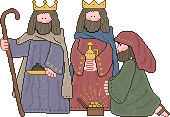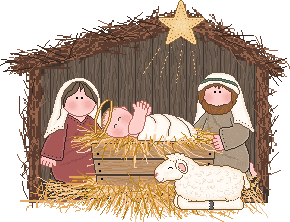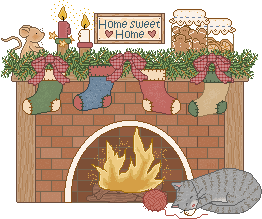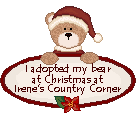
Merry Christmas


Christmas has always been my favorite time of year and some of my fondest memories as a child were watching my dad string up Christmas lights on our house and decorating our tree. Christmas is a special time for our family to gather and celebrate with gifts, dinner, our Lord Jesus, and a birthday! Yes, the holiday season was made even more special with the blessing of our daughter the day after Christmas. Sharing traditions I grew to love with my own children has created such wonderful memories for my family to cherish!
The Gospel of Luke, 2:1-20
The Christmas Story

And it came to pass in those days, that there went out a decree from Caesar Augustus, that all the world should be taxed. (And this taxing was first made when Cyrenius was governor of Syria.) And all went to be taxed, every one into his own city. And Joseph also went up from Galilee, out of the city of Nazareth, into Judea, unto the city of David, which is called Bethlehem (because he was of the house and lineage of David), to be taxed with Mary his espoused wife, being with child. And so it was, that, while they were there, the days were accomplished that she should be delivered. And she brought forth her firstborn son, and wrapped him in swaddling clothes, and laid him in a manger; because there was no room for them in the inn.

And there were in the same country shepherds abiding in the field, keeping watch over their flock by night. And lo, the angel of the Lord come upon them, and the glory of the Lord shone round about them: and they were sore afraid. And the angel said unto them, "Fear not: for, behold, I bring you good tidings of great joy, which shall be to all people. For unto you is born this day in the city of David a Savior, which is Christ the Lord. And this shall be a sign unto you; Ye shall find the babe wrapped in swaddling clothes, lying in a manger." And suddenly there was with the angel a multitude of the heavenly host praising God, and saying, "Glory to God in the highest, and on earth peace, good will toward men."



And it came to pass, as the angels were gone away from them into heaven, the shepherds said one to another: "Let us now go even unto Bethlehem, and see this thing which is to come to pass, which the Lord hath made known unto us." And they came with haste, and found Mary and Joseph, and the babe lying in a manger. And when they had seen it, they made known abroad the saying which was told them concerning this child. And all that heard it wondered at those things which were told them by the shepherds. But Mary kept all these things, and pondered them in her heart. And the shepherds returned, glorifying and praising God for all the things that they had heard and seen, as it was told unto them.


'Twas the Night Before
Christmas



'Twas the night before Christmas, when all through the house
Not a creature was stirring, not even a mouse;
The stockings were hung by the chimney with care,
In hopes that Saint Nicholas soon would be there;
The children were nestled all snug in their beds,
While visions of sugar-plums danced in their heads;
And ma in her 'kerchief, and I in my cap,
Had just settled our brains for a long winter's nap,
When out on the lawn there arose such a clatter,
I sprang from the bed to see what was the matter.
Away to the window I flew like a flash,
I tore open the shutters and threw up the sash.

The moon on the breast of the new-fallen snow
Gave the lustre of mid-day to objects below.
When, what to my wondering eyes should appear,
But a miniature sleigh and eight tiny reindeer,
With a little old driver, so lively and quick,
I knew in a moment it must be St. Nick.
More rapid than eagles his coursers they came,
And he whistled, and shouted, and called them by name:
"Now, Dasher! Now, Dancer! Now, Prancer and Vixen!
On, Comet! On, Cupid! On, Donner and Blitzen!
To the top of the porch! To the top of the wall!
Now dash away! Dash away! Dash away all!"
And dry leaves that before the wild hurricane fly,
When they meet with an obstacle, mount to the sky,
So up to the house-top the coursers they flew,
With the sleigh full of toys, and Saint Nicholas too.



And then, in a twinkling, I heard on the roof
The prancing and pawing of each little hoof.
As I drew in my hand, and was turning around,
Down the chimney Saint Nicholas came with a bound.
He was dressed all in fur, from his head to his foot,
And his clothes were all tarnished with ashes and soot;
A bundle of toys he had flung on his back,
And he looked like a peddler just opening his pack.
His eyes - how they twinkled! His dimples - how merry!
His cheeks were like roses, his nose like a cherry!
His droll little mouth was drawn up like a bow,
And the beard of his chin was as white as the snow;
The stump of a pipe he held tight in his teeth,
And the smoke it encircled his head like a wreath;
He had a broad face and a little round belly,
That shook, when he laughed like a bowl full of jelly.
He was chubby and plump, a right jolly old elf,
And I laughed when I saw him, in spite of myself;
A wink of his eye and a twist of his head,
Soon gave me to know I had nothing to dread.
He spoke not a word, but went straight to his work,
And filled all the stockings; then turned with a jerk,
And laying his finger aside of his nose,
And giving a nod, up the chimney he rose.
He sprang to his sleigh, to his team gave a whistle,
And away they all flew like the down of a thistle.
But I heard him exclaim as he drove out of sight,
"Happy Christmas to all, and to all, a Good Night!"

According to legend, Clement Clarke Moore wrote his immortal poem, A Visit from St. Nicholas (also known as The Night Before Christmas), for his family on Christmas Eve in 1822. It was not intended to be published, but a family friend, Miss Harriet Butler, learned of the poem from Moore's children. She copied it into her album, and submitted it to the editor of the Troy (New York) Sentinel where it made its first appearance in print on December 23, 1823. It was not until 1844, that Moore himself acknowledged authorship in a volume of his poetry entitled Poems, published at the request of his children.


Santa Claus

The belief that a whimsical figure brought gifts for children during the winter season can be traced back to ancient times, and the tradition of presenting gifts began even before the inception of Christianity and took its place in European folklore. And as quirky as it may sound, legends of some countries even included trolls, elves and goblins handing out gifts as well. In the context of Christianity, one can trace back gift-giving to the tale of the 'Three Kings' who are said to have offered gifts to baby Jesus. Almost all Christmas characters have been inspired by a humble man, called Saint Nicholas, and his generosity.
The legend of Santa Claus can be traced back hundreds of years to a monk named St. Nicholas. It is believed that Nicholas was born sometime around 280 A.D. in Patara, near Myra in modern-day Turkey. Much admired for his piety and kindness, St. Nicholas became the subject of many legends. It is said that he gave away all of his inherited wealth and traveled the countryside helping the poor and sick. One of the best-known St. Nicholas stories is the time he saved three poor sisters from being sold into slavery or prostitution by their father by providing them with a dowry so that they could be married. Centuries have passed and Christmas traditions have evolved over the years, but the tradition of gift-giving is still followed and around the world, there are quite a few different names for Santa Claus.
America and Canada; England (UK) - "Santa Claus" or "Kris Kringle" is believed to travel around the world sporting a red suit and riding in a sleigh, pulled by reindeer. He comes down the chimney the night before Christmas, leaving presents for children under the Christmas tree. Children often leave out stockings that Santa can fill with small gifts and sweets. Some families will leave a snack for him for his travels, usually milk and cookies to keep him going. He’s got a lot of presents to deliver, after all! In England he is known as "Father Christmas" and it's common to leave mince pie (a traditional festive pastry), a glass of whiskey/sherry for Santa, and carrots for the reindeer!
The Netherlands - "Sinterklaas" is the Dutch name for Santa. It sort of sounds familiar, right? That's because it's where we got the name Santa Claus from in the first place. Since the 11th century, the Netherlands has been celebrating Saint Nicholas, or Sinterklass, a 4th-century bishop who was the patron saint of children and sailors. Dutch settlers came to the United States, bringing their customs with them - including the story of Saint Nick, who is said to have arrived by boat from Spain every year on December 5th to leave treats for Dutch children in their shoes. In America, Sinterklaas became Santa Claus. And funnily enough, our Americanized version of the character eventually traveled back to Holland under the name Kerstman (Christmas man), which means the children of The Netherlands now have two gift-giving visitors to look forward to every year!
Germany - "Nikolaus", "Weihnachtsmann", or "Christkind" are the gift-givers in Germany. The festive season in Germany starts early, with Nikolaustag (St. Nicholas Day) on the 6th of December. It is thought that Nikholaus comes in the night riding a white horse, and puts presents in the children’s shoes, which are usually polished and placed by their front doors the evening before. In some parts of Germany, das Christkind (Christ child) is thought to bring children presents on Christmas Eve. In other parts of the country, der Weihnachtsmann (Santa Claus) is the one who brings presents to the children. Children also write to him asking for presents before Christmas. They even decorate their letters by gluing sugar to the envelope! Traditionally, German people open their presents on Christmas Eve rather than Christmas Day.

Christmas Legends
Practically every Christmas tradition has a whimsical legend behind it. Indeed, quite a few of these legends have ended up becoming Christmas traditions that families continue to celebrate during the holiday season. Here are a few of my favorites!
Legend of the Evergreens
Since winter was fast approaching, all the birds began to fly towards south for warmer weather. A little bird broke a wing on the way and could not fly further along with the other birds. The poor thing fell into the strange woods. When winter came, it started snowing and soon, the entire forest was covered with snow. The little bird found it very difficult to even fly up to a tree. As the ground was covered with snow everywhere, she could not even spot worms and hence feared for her life. The only way out for her was to ask for help from the trees, in order to stay alive. It was of no use as the trees weren't kind at all. She approached the birch tree which was vain and proud over its beauty. It refused help saying that it had to protect the birds of the forest first.
The oak tree refused help saying that it was scared that the bird would overstay and eat up its acorns in spring. The otherwise gentle willow tree too refused to provide any help to the bird. The bird lost all hope and was distressed. With all its efforts in vain, it tried to fly again but the broken wings were of no help. Seeing this, the spruce tree asked her what was wrong. When the bird shared her problem with it, the tree gave the bird the thickest and warmest branch of all.
Seeing the kindness of the spruce tree, the pine tree also offered protection to the tree and the bird by protecting them from the North Wind throughout the winter season. Seeing this, the little juniper tree also came up to the bird's aid and offered its berries to satisfy her hunger. Hence, winter passed by and the bird was safe and warm. In due time, her broken wings were also healed and by spring, she was ready to fly back to her friends.
The behavior of all the trees was kept in check by the Frost King, who commanded the North Wind not to touch even a single leaf of the generous spruce, pine or the juniper trees. However, the North Wind plucked the green shining leaves of the oak, willow and other trees for refusing to help the little bird. The winds left them bare for the winters so that they had nothing to protect themselves from the rain, snow and sleet. Thus, it is for this reason that the leaves of the pine, spruce and the juniper are always green and these trees are referred to as the evergreen trees.
For thousands of years, cultures from Egypt to Northern Europe have celebrated the Winter solstice by decorating their homes with green palm fronds and evergreen boughs to breathe life into the shortest, darkest day of the year. The first Christmas trees were brought indoors by 16th-century German Christians, and Martin Luther is credited with placing the first burning candles in a Christmas tree to mimic the sparkling stars. Puritanical American preachers railed against “pagan” Christmas trees and the tradition didn’t catch on in U.S. homes until the 1890s.
Legend of the Poinsettia
A long time ago in Mexico, there lived a little girl called Maria and her brother Pablo. They were from a poor family. Maria and her brother looked forward to Christmas when, every year, the local church set up a nativity scene. Even before Christmas, the celebrations usually started with a lot of pomp and show. Maria and Pablo loved Christmas, but they were disheartened because they could not afford to give the baby Jesus a gift on his birthday. As they walked to the Church that Christmas Eve, Maria was not happy, but sad. As she and her brother were walking, an angel came to them and said, "All you have to do is gather what's at your feet."
Hearing this, the children obeyed and diligently gathered the weeds that were on the side of the road. They proceeded to the Church, and by now Maria's heart was lighter because she knew that she was giving the Lord a gift which was filled with love. The other children jeered and mocked them. Maria and her brother placed the weeds near the crib of Jesus. Looking at them doing this, the other children started embarrassing them and almost brought Maria to tears. At this instant there was a miracle. The green weeds turned into beautiful red star shaped flowers. The other children stopped laughing at them and were stunned at what had happened. They realized that a gift did not have to be expensive; it must be given from the heart to be accepted by the Lord.
In Mexico, poinsettias grow wild in large bushes that flush with bright red leaves in the dead of winter. In fact, in Mexico poinsettias are called “flor de nochebuena” or “Christmas Eve flower.” They got their odd English name from Joel R. Poinsett, the very first U.S. minister to Mexico, who brought back the red-and-green plants from a visit in 1828. Christmas was just beginning to be widely celebrated in America, and Poinsett rightly predicted that the festive plants would be a seasonal hit. By 1900, they were a universal symbol of Christmas.


Legend of The Robin
The night when Jesus was born was so cold and chilly that Mother Mary was unable to keep infant Jesus warm in the stable. The wind blew constantly into the stable and the fire was about to go off. Mother Mary was worried and asked the animals in her stable for help. First she asked the ox to blow on the embers so that the fire continues. But the ox was fast asleep and couldn't hear Mother Mary's cry for help. Next, she asked the donkey, horse and the sheep, but in vain.
Mother Mary had lost hope, but she was surprised when she heard the continuous flapping of a bird's wings. The bird was none other than the robin. Seeing Mother Mary's helplessness, he decided to help her keep the stable warm. So, he flapped his wings rigorously at the dying embers and fetched some dry sticks for the fire. This stopped the fire from going out completely, but the flame that rose suddenly, burnt the little bird's breast and turned it red. Despite getting hurt, the bird continued his efforts to keep the fire going, just to keep the stable warm for infant Jesus. Mother Mary was so moved by the kind gesture of this little bird that she blessed the bird in the morning, saying that "From now on, let your red breast be a reminder of your good deed".
Legend of The Nutcracker
The nutcracker's origin comes from the Erzgebirge region of Germany. These dolls were first made in the 1700's, due to the ample supply of wood and depleting supply of metal. Carving these intricate wooden nutcrackers became the livelihood of the people. Today, the German nutcracker is a valued possession and collectible over all others. It takes 130 steps to create this magnificent piece of art. The book The Legend of the Nutcracker and Traditions of the Erzgebige, written by Ken Althoff, speaks of an old German folktale about how the nutcracker came into being. The story stated that there was a farmer who offered a reward to anyone who could help him crack the walnuts that grew on his tree. A carpenter told him to saw the nut in half, while a soldier told him to shoot the nut. It was finally a puppet maker who came along with a beautiful puppet made of wood and painted in bright colors, which had strong jaws that could be used to crack the walnuts. The farmer rewarded him by giving him his own workshop.
Though this is just a folktale, in Germany it is said that nutcrackers bring good luck and protect the house and it's inhabitants, keeping evil at bay. For over 200 years, the Steinbach family has been making nutcrackers. They were originally made to look like soldiers or generals, but Herr Steinbach introduced nutcrackers that looked like characters from different parts of the world. Herr Steinbach's uniqueness added a whole new level of quality to the nutcrackers and got them selling. Today, the family operation is headed by Herr Steinbach, with his daughter Karla being second in command.
The Nutcracker Ballet is based on the book called The Nutcracker and the Mouse King, written by E.T.A. Hoffman. In 1891, the legendary choreographer Marius Petipa, commissioned Tchaikovsky to write the music for the Nutcracker Ballet. In 1892, the first showing of the Nutcracker took place at the Mariinsky Theatre of Russia, home of the Kirov Ballet. The Nutcracker made its way to Western Europe in the 1930's and to America by 1940, performed by Ballet Russe. The first American full length Nutcracker was performed by the San Francisco Ballet, choreographed by W. Christensen. The Nutcracker has since become an annual Holiday tradition.















